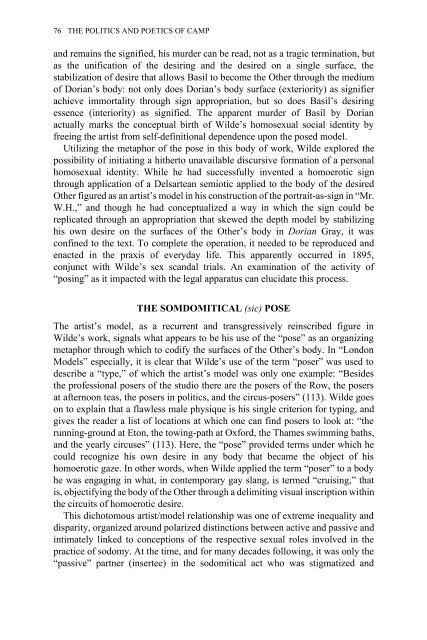Edited by Moe Meyer - Get a Free Blog
Edited by Moe Meyer - Get a Free Blog
Edited by Moe Meyer - Get a Free Blog
You also want an ePaper? Increase the reach of your titles
YUMPU automatically turns print PDFs into web optimized ePapers that Google loves.
76 THE POLITICS AND POETICS OF CAMP<br />
and remains the signified, his murder can be read, not as a tragic termination, but<br />
as the unification of the desiring and the desired on a single surface, the<br />
stabilization of desire that allows Basil to become the Other through the medium<br />
of Dorian’s body: not only does Dorian’s body surface (exteriority) as signifier<br />
achieve immortality through sign appropriation, but so does Basil’s desiring<br />
essence (interiority) as signified. The apparent murder of Basil <strong>by</strong> Dorian<br />
actually marks the conceptual birth of Wilde’s homosexual social identity <strong>by</strong><br />
freeing the artist from self-definitional dependence upon the posed model.<br />
Utilizing the metaphor of the pose in this body of work, Wilde explored the<br />
possibility of initiating a hitherto unavailable discursive formation of a personal<br />
homosexual identity. While he had successfully invented a homoerotic sign<br />
through application of a Delsartean semiotic applied to the body of the desired<br />
Other figured as an artist’s model in his construction of the portrait-as-sign in “Mr.<br />
W.H.,” and though he had conceptualized a way in which the sign could be<br />
replicated through an appropriation that skewed the depth model <strong>by</strong> stabilizing<br />
his own desire on the surfaces of the Other’s body in Dorian Gray, it was<br />
confined to the text. To complete the operation, it needed to be reproduced and<br />
enacted in the praxis of everyday life. This apparently occurred in 1895,<br />
conjunct with Wilde’s sex scandal trials. An examination of the activity of<br />
“posing” as it impacted with the legal apparatus can elucidate this process.<br />
THE SOMDOMITICAL (sic) POSE<br />
The artist’s model, as a recurrent and transgressively reinscribed figure in<br />
Wilde’s work, signals what appears to be his use of the “pose” as an organizing<br />
metaphor through which to codify the surfaces of the Other’s body. In “London<br />
Models” especially, it is clear that Wilde’s use of the term “poser” was used to<br />
describe a “type,” of which the artist’s model was only one example: “Besides<br />
the professional posers of the studio there are the posers of the Row, the posers<br />
at afternoon teas, the posers in politics, and the circus-posers” (113). Wilde goes<br />
on to explain that a flawless male physique is his single criterion for typing, and<br />
gives the reader a list of locations at which one can find posers to look at: “the<br />
running-ground at Eton, the towing-path at Oxford, the Thames swimming baths,<br />
and the yearly circuses” (113). Here, the “pose” provided terms under which he<br />
could recognize his own desire in any body that became the object of his<br />
homoerotic gaze. In other words, when Wilde applied the term “poser” to a body<br />
he was engaging in what, in contemporary gay slang, is termed “cruising,” that<br />
is, objectifying the body of the Other through a delimiting visual inscription within<br />
the circuits of homoerotic desire.<br />
This dichotomous artist/model relationship was one of extreme inequality and<br />
disparity, organized around polarized distinctions between active and passive and<br />
intimately linked to conceptions of the respective sexual roles involved in the<br />
practice of sodomy. At the time, and for many decades following, it was only the<br />
“passive” partner (insertee) in the sodomitical act who was stigmatized and


